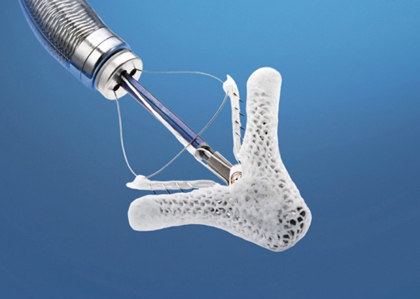Courtesy of Dr. Carlos Fava.
Repairing the mitral valve with Mitraclip has become an alternative for high risk or inoperable symptomatic patients, but its long term evolution has only been tested by the EVEREST II, which had not taken into account 5 year mortality outcomes. Therefore, to better study its evolution, we need to carry out different randomized studies or registries.
In this opportunity, the work we are looking into is an observational study carried out by two centers in Germany, including 126 consecutive patients. In contrast with the EVEREST, this study included patients presenting <25% ejection fraction, >55 mm, end-systolic diameter, including segments A2/P2, and a <2 mm coaptation length.
Mean age was 72, more than half of patients were men, ejection fraction was 48%, almost all patients presented mitral regurgitation (MR) ≥3, only two suffered grade 2 MR with refractory cardiac failure, 51 (40.5%) had MR secondary to AMI, in 2 it was secondary to AMI with cardiogenic shock.
Only 60.3% of the population presented the EVEREST criteria.
Also read: “Bad Prognosis for Post-MitraClip Mitral Valve Stenosis: What Should We Do?”.
After MitraClip, 70 patients (55.6%) reduced MR to grade 1 and 116 (92.1%) to grade ≤2. 94 patients received only one clip, 30 received 2, and 2 received 3.
Follow up was at 5 years in 95.2% of the population. Mortality increased to 45 patients (35.7%), 19 patients saw reintervention (15.1%), 14 went to surgery and 7 got a new MitraClip (2 of these went to surgery afterwards).
Most of functional class to ≤I NYHA was 69%.
In multivariable analysis, post MitraClip MR grade, ejection fraction and glomerular filtration rate were independent predictors of mortality.
Also read: “MitraClip: should we indicate it earlier?”
Patients presenting primary MR were compared to those presenting secondary MR. The primary MR group presented better ventricular function, both right and left, better kidney function, less AMI and less cardiac surgery. Their evolution was significantly better than those presenting secondary MR, especially when post MitraClip MR was ≤1. Instead, evolution in the secondary MR group was similar when post MitraClip MR was between 1 and 2.
Conclusion
This study determined long term evolution predictors after mitral valve percutaneous intervention and showed that long term survival is determined by the residual gradient. These data suggest we should reduce residual MR to the lowest possible grade after transcatheter edge-to-edge mitral valve repair, especially in high risk patients with primary MR that are no good candidates for mitral valve surgery.
Comment
This study analyzes symptomatic patients at high risk in the “real world”, with good long term evolution, especially with mild MR after MitraClip.
MR evolution is long and kidney and ejection fraction deterioration takes long to develop. Therefore, we should intervene before this happens in order to improve evolution.
Mortality was higher in the EVEREST (35.7% vs. 20.8%), but we should bear in mind this is a population with more comorbidities.
The limitation is that this is a two center study, in Germany, not randomized and outcomes improved with the learning curve.
Courtesy of Dr. Carlos Fava.
Original title: Predictors for long-term survival after transcatheter edge-to-edge mitral valve repair.
Reference: Mathias Orban, et al. J Interv Cardiol 2017;30:226-233.
Subscribe to our weekly newsletter
Get the latest scientific articles on interventional cardiology
We are interested in your opinion. Please, leave your comments, thoughts, questions, etc., below. They will be most welcome.






